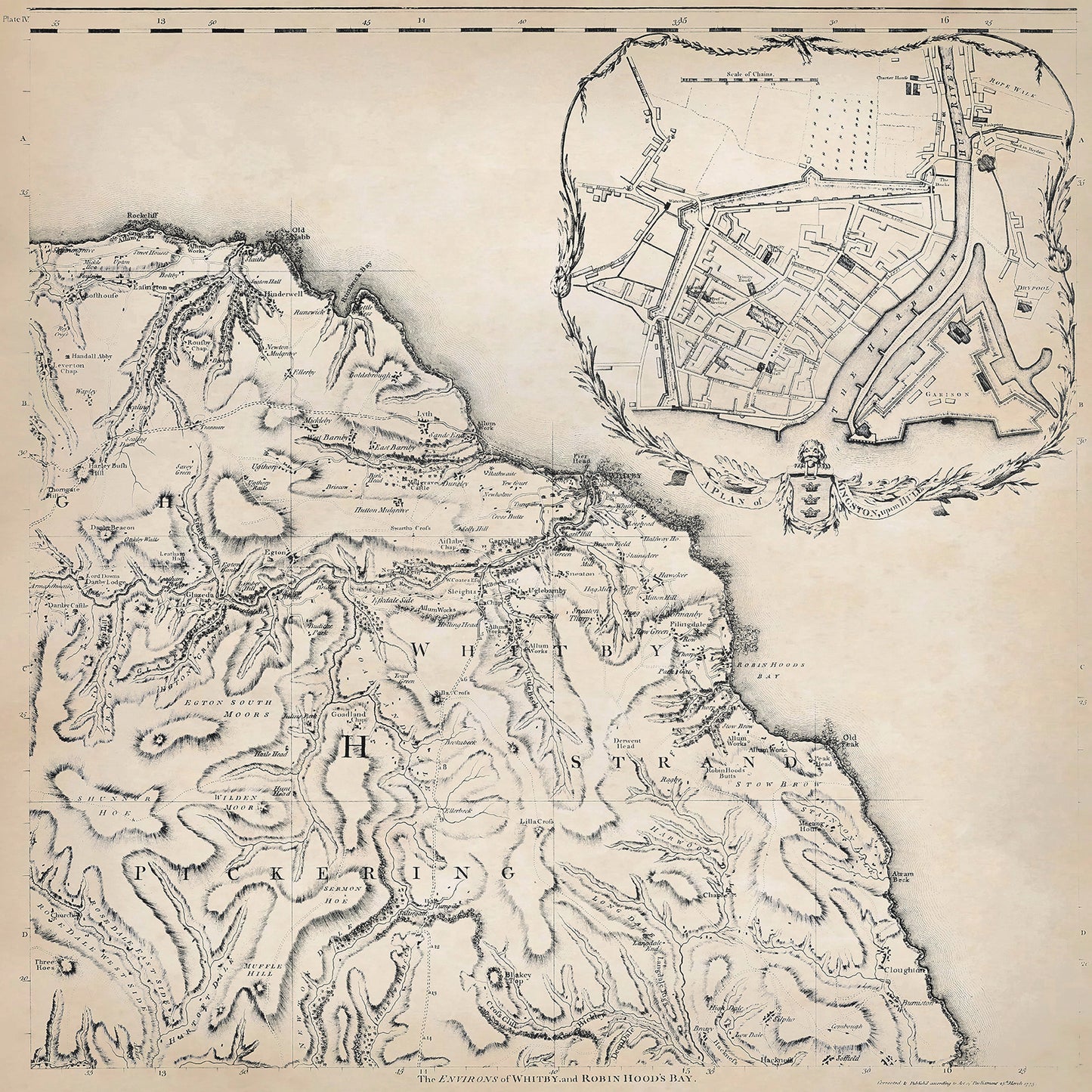Elite Wall Decor
Yorkshire in 1771 sheet 1-4 - features a Plan of Kingston upon Hull and shows the Whitby and Robin Hood Bay area
Yorkshire in 1771 sheet 1-4 - features a Plan of Kingston upon Hull and shows the Whitby and Robin Hood Bay area
Couldn't load pickup availability
Downloading this large file to phones or tablets is not recommended
This digital download is a high-quality 300dpi JPG image of one sheet from Thomas Jefferys "The County of York Survey'd" published in 1771. The image is crisp, clear and easy to read. It measures 60 x 60 cm, or 7087 x 7087 pixels but can be cropped or resized with the appropriate software. Download now to print whole or in part at home, or simply view it in close up on your device using image software such as Adobe Photoshop, Gimp, Windows Photo, or similar.
FOR PLAN OF HULL:
In the late 18th century, the Yorkshire town of Kingston upon Hull, commonly known as Hull, was a bustling port and commercial center with a vibrant economy.
Hull's economy during the late 18th century supported a wide range of occupations. As a port town, many residents were involved in maritime activities. Sailors, dockworkers, shipbuilders, and fishermen played crucial roles in the shipping and trading industries. The town also had a significant number of merchants and traders who engaged in domestic and international commerce.
The maritime industry was the backbone of Hull's economy in the late 18th century. The port of Hull was a hub of trade and shipping, connecting Yorkshire with various parts of Britain and the wider world. Merchants in Hull traded in a diverse range of goods, including wool, textiles, coal, salt, and timber. Shipbuilding was another important industry, with several shipyards along the River Hull.
Hull was also known for its fishing industry. Fishing boats from Hull ventured into the North Sea to catch herring and cod, which were processed, salted, and exported to other regions. The fish processing industry supported jobs for gutters, curers, and coopers.
Hull's historic Old Town featured a network of narrow streets and a collection of charming medieval and Georgian buildings. The town's architecture reflected its rich history as a trading center and port.
The Hull Trinity House, a charitable organization founded in the 14th century, played a significant role in the maritime community. It provided support to seafarers, including the provision of pilots, navigation aids, and care for retired mariners. The Hull Trinity House also had an iconic building in the Old Town.
The River Hull and its associated docks were focal points of activity. The waterfront was lined with warehouses and wharves, bustling with ships loading and unloading goods. The Humber Dock, constructed in the late 18th century, served as a significant hub for maritime trade, accommodating larger vessels.
The town had various public buildings, including churches, almshouses, and the Guildhall, which served as the administrative center. The Hull Grammar School, established in the 16th century, provided education to local children.
In addition, Hull hosted regular markets and fairs, attracting traders from the surrounding countryside and further afield.
Whitby and Robin Hood Bay
Whitby:
Whitby is a historic fishing town located on the east coast of Yorkshire. It had a bustling harbor, picturesque cliffs, and a rich maritime heritage.
Fishing was the dominant occupation in Whitby during the late 18th century. The town's fishermen ventured into the North Sea in their fishing boats, primarily targeting cod, herring, and mackerel. The catch was processed and salted locally before being traded and exported. The fishing industry supported various roles, such as fishermen, boatbuilders, net menders, and fishmongers.
In addition to fishing, Whitby had a shipbuilding industry. Shipyards constructed vessels, including fishing boats, cargo ships, and naval vessels. Shipbuilding provided employment for shipwrights, carpenters, and other skilled workers.
Whitby's maritime location also contributed to its ship provisioning industry. The town supplied ships with essentials such as food, water, and equipment. Chandleries and merchants catered to the needs of sailors and ship owners.
Whitby was a significant center for whaling during this period. Whaling ships set sail from Whitby to hunt for whales in the Arctic waters. The captured whales provided oil for lighting and other products. The whaling industry supported a range of occupations, including whalers, harpooners, blubber processors, and coopers.
Whitby Abbey, situated on the town's east cliff, was a prominent landmark. The ruins of the abbey, dating back to the 13th century, provided a picturesque backdrop for the town. The abbey also had historical and cultural significance, attracting visitors and serving as a source of inspiration for writers and artists.
Robin Hood's Bay:
Robin Hood's Bay is a charming fishing village located about five miles south of Whitby. It is known for its narrow winding streets, steep cliffs, and scenic beauty.
Fishing was the primary occupation in Robin Hood's Bay, similar to Whitby. Local fishermen set sail to catch cod, herring, and shellfish. The catch was brought back to the village and either sold locally or transported to other markets. Fishermen, net menders, and fishmongers were involved in the fishing industry.
Apart from fishing, Robin Hood's Bay had limited industrial activity. Some residents engaged in small-scale agriculture, cultivating crops in the surrounding fields and keeping livestock. The town also had a small craft industry, with artisans producing handmade items such as pottery, baskets, and woodwork.
Robin Hood's Bay is renowned for its picturesque coastal scenery and historic architecture. The village's narrow streets, quaint cottages, and sea views attracted visitors and holidaymakers even during the late 18th century.
The smugglers' history of Robin Hood's Bay added an element of intrigue to the town. Smuggling was prevalent along the Yorkshire coast during this period, and Robin Hood's Bay was known for its smuggling activities. Hidden passageways, caves, and secret compartments in houses were associated with the smuggling trade.

